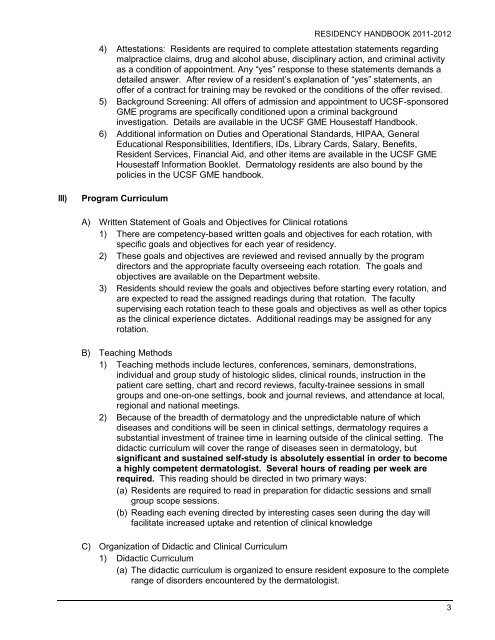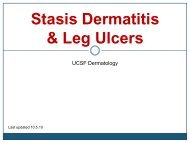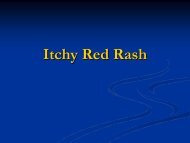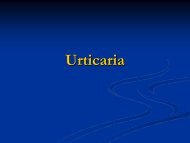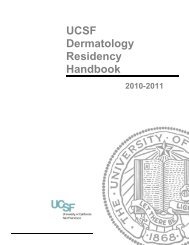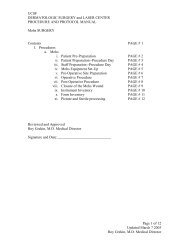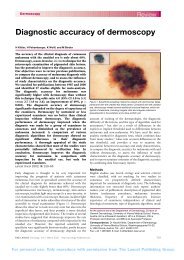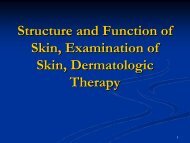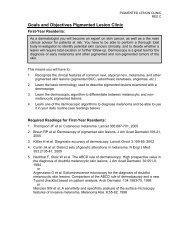UCSF Dermatology Residency Handbook - Dermatology - University ...
UCSF Dermatology Residency Handbook - Dermatology - University ...
UCSF Dermatology Residency Handbook - Dermatology - University ...
Create successful ePaper yourself
Turn your PDF publications into a flip-book with our unique Google optimized e-Paper software.
RESIDENCY HANDBOOK 2011-2012<br />
4) Attestations: Residents are required to complete attestation statements regarding<br />
malpractice claims, drug and alcohol abuse, disciplinary action, and criminal activity<br />
as a condition of appointment. Any “yes” response to these statements demands a<br />
detailed answer. After review of a resident’s explanation of “yes” statements, an<br />
offer of a contract for training may be revoked or the conditions of the offer revised.<br />
5) Background Screening: All offers of admission and appointment to <strong>UCSF</strong>-sponsored<br />
GME programs are specifically conditioned upon a criminal background<br />
investigation. Details are available in the <strong>UCSF</strong> GME Housestaff <strong>Handbook</strong>.<br />
6) Additional information on Duties and Operational Standards, HIPAA, General<br />
Educational Responsibilities, Identifiers, IDs, Library Cards, Salary, Benefits,<br />
Resident Services, Financial Aid, and other items are available in the <strong>UCSF</strong> GME<br />
Housestaff Information Booklet. <strong>Dermatology</strong> residents are also bound by the<br />
policies in the <strong>UCSF</strong> GME handbook.<br />
III) Program Curriculum<br />
A) Written Statement of Goals and Objectives for Clinical rotations<br />
1) There are competency-based written goals and objectives for each rotation, with<br />
specific goals and objectives for each year of residency.<br />
2) These goals and objectives are reviewed and revised annually by the program<br />
directors and the appropriate faculty overseeing each rotation. The goals and<br />
objectives are available on the Department website.<br />
3) Residents should review the goals and objectives before starting every rotation, and<br />
are expected to read the assigned readings during that rotation. The faculty<br />
supervising each rotation teach to these goals and objectives as well as other topics<br />
as the clinical experience dictates. Additional readings may be assigned for any<br />
rotation.<br />
B) Teaching Methods<br />
1) Teaching methods include lectures, conferences, seminars, demonstrations,<br />
individual and group study of histologic slides, clinical rounds, instruction in the<br />
patient care setting, chart and record reviews, faculty-trainee sessions in small<br />
groups and one-on-one settings, book and journal reviews, and attendance at local,<br />
regional and national meetings.<br />
2) Because of the breadth of dermatology and the unpredictable nature of which<br />
diseases and conditions will be seen in clinical settings, dermatology requires a<br />
substantial investment of trainee time in learning outside of the clinical setting. The<br />
didactic curriculum will cover the range of diseases seen in dermatology, but<br />
significant and sustained self-study is absolutely essential in order to become<br />
a highly competent dermatologist. Several hours of reading per week are<br />
required. This reading should be directed in two primary ways:<br />
(a) Residents are required to read in preparation for didactic sessions and small<br />
group scope sessions.<br />
(b) Reading each evening directed by interesting cases seen during the day will<br />
facilitate increased uptake and retention of clinical knowledge<br />
C) Organization of Didactic and Clinical Curriculum<br />
1) Didactic Curriculum<br />
(a) The didactic curriculum is organized to ensure resident exposure to the complete<br />
range of disorders encountered by the dermatologist.<br />
3


